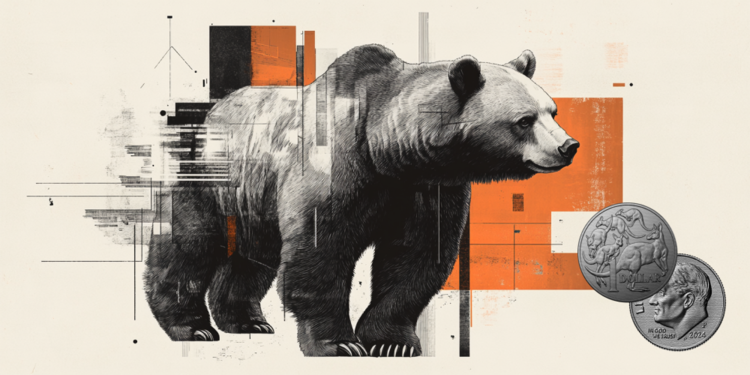- AUD/USD falls like there is no tomorrow due to a significant acceleration in RBA dovish bets.
- The RBA is expected to cut its Official Cash Rate (OCR) in all three next policy meetings.
- US NFP data for March has come in at 228K, beating estimates of 135K.
The AUD/USD pair tanks more than 3.5% below 0.6100 during early North American trading hours on Friday. The Aussie pair plummets like a house of cards as the new suite of tariffs by United States (US) President Donald Trump has prompted market expectations for the Reserve Bank of Australia (RBA) to cut interest rates aggressively this year. The pair has made an intraday low of 0.6049, the lowest level seen in almost five years.
Australian Dollar PRICE Today
The table below shows the percentage change of Australian Dollar (AUD) against listed major currencies today. Australian Dollar was the strongest against the New Zealand Dollar.
| USD | EUR | GBP | JPY | CAD | AUD | NZD | CHF | |
|---|---|---|---|---|---|---|---|---|
| USD | 0.15% | 0.64% | -0.44% | 0.85% | 3.49% | 2.66% | -0.89% | |
| EUR | -0.15% | 0.54% | -0.58% | 0.75% | 3.34% | 2.55% | -0.98% | |
| GBP | -0.64% | -0.54% | -1.10% | 0.21% | 2.82% | 2.02% | -1.52% | |
| JPY | 0.44% | 0.58% | 1.10% | 1.36% | 3.99% | 3.10% | -0.39% | |
| CAD | -0.85% | -0.75% | -0.21% | -1.36% | 2.56% | 1.76% | -1.72% | |
| AUD | -3.49% | -3.34% | -2.82% | -3.99% | -2.56% | -0.78% | -4.22% | |
| NZD | -2.66% | -2.55% | -2.02% | -3.10% | -1.76% | 0.78% | -3.46% | |
| CHF | 0.89% | 0.98% | 1.52% | 0.39% | 1.72% | 4.22% | 3.46% |
The heat map shows percentage changes of major currencies against each other. The base currency is picked from the left column, while the quote currency is picked from the top row. For example, if you pick the Australian Dollar from the left column and move along the horizontal line to the US Dollar, the percentage change displayed in the box will represent AUD (base)/USD (quote).
Analysts at ANZ Bank expect the RBA to cut interest rates in all the next three policy meetings in May, July, and August. Additionally, the bank also sees the possibility of a larger-than-usual interest rate cut of 50 basis points (bps) in May if global growth deteriorates significantly.
In addition to bloating RBA dovish bets, fears of a potential trade war between the US and China have also weighed on the Australian Dollar (AUD). During European trading hours on Friday, Beijing threatened to impose additional tariffs of 34% on all US imports from April 10 as a countermeasure to Trump’s reciprocal tariffs announced on Wednesday.
Escalating concerns over the surrendering Chinese economic outlook weighs on the Aussie dollar, given that Australia relies significantly on its exports to China.
Meanwhile, the US Dollar (USD) strives to gauge support due to comfort from upbeat Nonfarm Payrolls (NFP) data for March after surrendering its intraday gains. The US NFP report showed that the economy added 228K fresh workers, significantly higher than estimates of 135K and the former reading of 117K, downwardly revised from 151K. The Unemployment Rate accelerated to 4.2% against estimates and the prior release of 4.1%.
Average Hourly Earnings, a key measure of wage growth, rose moderately by 3.8% year-on-year compared to expectations of 3.9% and the former reading of 4%.
Economic Indicator
Nonfarm Payrolls
The Nonfarm Payrolls release presents the number of new jobs created in the US during the previous month in all non-agricultural businesses; it is released by the US Bureau of Labor Statistics (BLS). The monthly changes in payrolls can be extremely volatile. The number is also subject to strong reviews, which can also trigger volatility in the Forex board. Generally speaking, a high reading is seen as bullish for the US Dollar (USD), while a low reading is seen as bearish, although previous months’ reviews and the Unemployment Rate are as relevant as the headline figure. The market’s reaction, therefore, depends on how the market assesses all the data contained in the BLS report as a whole.
Read more.
Read the full article here


